
Leaves that Trick!
Martin Witchard
We are all familiar with what a leaf looks like. At least, we think we all know what a leaf looks like. The difficulty arises when we must decide whether we are looking at a simple leaf, or a compound leaf. It is this small but persistent issue which constantly bemuses, frustrates and annoys botany students trying to make some headway in identification of particular plants.
A simple leaf is one which is not divided into smaller units (leaflets), while a compound leaf is one which is divided into two or more leaflets (Clarke and Lee 1990). Of course, the conundrum is how to KNOW whether the leaf or leaves you see are leaves or leaflets!
There are a few simple, general rules of thumb that you can follow to decide whether a plant has simple or compound leaves. These rules are not written anywhere (at least not written explicitly) and are one of the things botanists often seem to learn by 'osmosis' (i.e. having absorbed enough information and made the right connections, the botanist will know whether he/she is looking at a simple or compound leaf!).
Rule 1 - Look for axillary buds
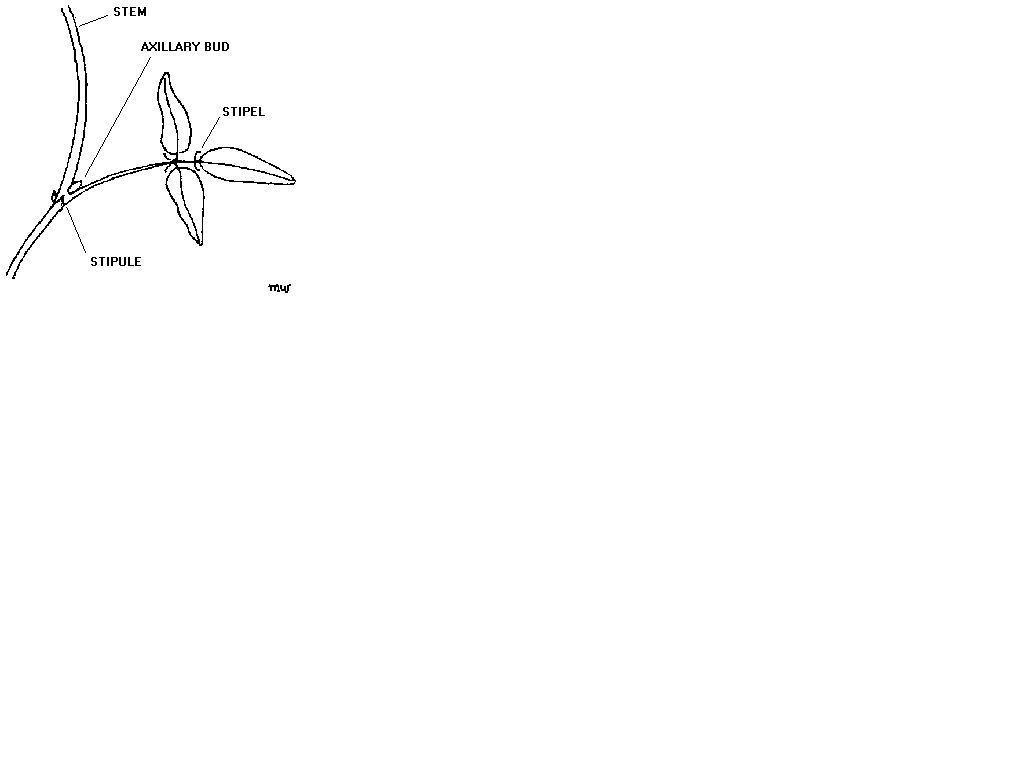 |
|
| Figure 1: Axillary buds ands their relationship to stipules and stipels |
|
Axillary buds are found in the axil (or angle) between the stem and the leaf (see Figure 1). They may (generally) go on to produce vegetative growth (stems, leaves) or reproductive growth (flowers). Usually the buds are prominent - rather plump, often tapered in shape, sometimes with overlapping scales.
If you can find axillary buds, then the organ above it is a true leaf, not a leaflet. Because leaflets are divided leaves there are NO axillary buds at their point of attachment with the rachis (the central 'axis' of the compound leaf).
Unfortunately, this rule has its flaw. Often, the axillary buds are undeveloped and may appear to be nothing more than pinpricks or completely absent! So, we have a second rule.
Rule 2 - Look for stipels
'Look for what?' I hear you say. Many plants have leaf-like structures just near the axillary buds, called stipules. They appear to be 'leaves' arising directly from the stem. The only difference is that they arise at right angles to the actual leaves, they are not on the same level as the actual leaves and, they do not have axillary buds. They also occur in pairs. Conspicuous stipules are often produced in plants of the pea family (the legumes). That's stipules. So what are stipels? If your 'leaf' has extra 'leafy' structures on its leaf stalk (see Figure 1) then these are stipels (pl. stipellae). They also occur in pairs in most cases. When stipels occur they are said to be 'subtending' the leaflet or leaflets. Again, many legumes have these structures.
Rule 3 - Look for multiple pulvini
 |
|
| Figure 2: Appearance and location of pulvini |
|
'Look for multiple whatsihoosits!?'. A pulvinus (pl. pulvini) is/are swellings found at the base of the leaf stalk and/or the base of the leaflet points of attachment in compound leaves. We suspect that they function by assisting in reduction of transpiration from the leaves/leaflets by causing them to 'droop' and reduce the area exposed to direct sunlight (see Figure 2).
Unfortunately, this neat theory does not suggest why some plants exhibit folding of leaves/leaflets at night-time (the so called 'sleep movements' of plants). Simple leaves may have a pulvinus at the base of their leaf stalks. Compound leaves may have a pulvinus not only at the base of the leaf stalk but also at the base of each leaflet. The oft quoted 'sensitive plant' (Mimosa pudica) has pulvini which react rapidly to touch, folding all the leaflets up so that the plant appears to be defoliated. If you find a 'leaf' with more than one pulvinus along its length then it is likely to be a compound leaf.
So there are the rules. The problem with the rules is that they assume previous knowledge about plant parts. However, this previous knowledge is fundamental to botanists, challenging for non-botanists, and requires understanding to fully appreciate the rules themselves! Science is full of these assumptions!
So, with the nitty-gritty out of the way let's look at some examples of compound leaves. They are a fascinating bunch of structures! We'll begin with the somewhat complex and work back to the tantalizingly simple...
Pinnate leaf
In this type of compound leaf the simple leaf has been 'once divided' (see Figure 3a). The central stalk has rows of leaflets either side. If there is no terminal leaflet in this arrangement it is termed paripinnate. If there is a terminal leaflet (therefore an odd number of leaflets) it is termed imparipinnate. Examples include dozens of wattle (Acacia spp.), some Boronia spp. and red cedar (Toona ciliata).
Bipinnate leaf
Here the leaf has been 'twice divided' (see Figure 3b). Think of the Cootamundra wattle (Acacia baileyana) or Mudgee wattle (A.spectabilis). And there are plenty of other plants that have this arrangement!
 |
 |
| Figures 3a and 3b: Compound leaf types: Pinnate (left) and Bipinnate (right) |
Tripinnate leaf
| |
 |
| |
Figure 3c: Compound leaf types: Tripinnate |
Up another level of complexity. You have a pinnate leaf, whose leaflets were divided once, then those leaflets were divided once again (Figure 3c).
What is an example? You could try looking at some members of the fern genus Adiantum (Maidenhair fern). Other than this I can't think of a native plant with this arrangement but there are a few exotics including Adonis and Thalictrum (both Family Ranunculaceae).
And, just for the record, there are no quadrupinnate leaves or higher!
Palmate leaf
A special type of compound leaf with five or seven leaflets which are all joined to a central stalk (see Figure 4a). Some examples are native grape (Cissus hypoglauca) and emufoot (Psoralea tenax). For some strange reason I find this arrangement rather aesthetic. One small technicality is that palmate may mean things with less than five leaflets too according to the Flora of New South Wales (Harden 1991). I'd like to disagree. The whole visual idea of palmate is to palm-like (the hand, not the plant!) in appearance. I can't imagine a hand having less than five digits (well, for that matter, more than five...).
Trifoliolate leaf
...or palmately 3-foliolate. From seven and five to three leaflets joined to a central stalk (Figure 4b). Really common; Glycine, Desmodium and Zieria, just to name a few genera. Occasionally there's a mutation to four leaflets as in a four-'leaved' clover (I have a patch down my backyard which frequently throws up four-leaflet clovers).
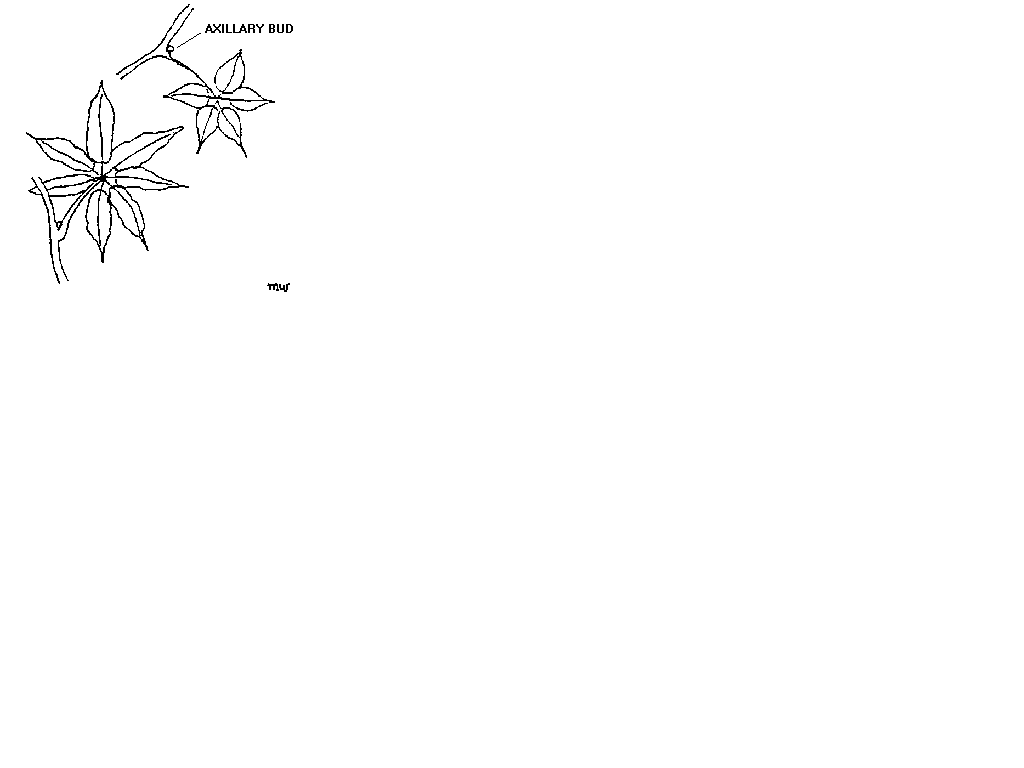 |
 |
| Figures 4a and 4b: Compound leaf types: Palmate (left) and Trifoliate (right) |
Bifoliolate leaf
....or perhaps more correctly, palmately 2-foliolate (Figure 4c). Yes, such a weird selection exists. At the moment I can't think any examples other than the genus Zornia (a mainly tropical genus, with representatives in Australia). The leaf stalk gives rise to two leaflets (sometimes four) allowing a most amusing spectacle when being identified by budding botanists.
Unifoliolate leaf
....1-foliolate - even the Flora knows when to give up on the palmate idea! (Figure 4d). The bane of many and the enigma of a few. What a wonderful plant is Hardenbergia violacea in having such a beautifully simple and yet wickedly elegant arrangement of a single leaflet. It appears to be a single leaf and yet it is the simplest of compound leaves! Meanwhile, the western counterpart of H.violacea, H.comptoniana has stupidly stuck with three leaflets (trifoliolate) and therefore forfeited its right to attract any great interest (in the author's immodest opinion). Two other unifoliolate plants in the legume group are Desmodium gangeticum and Isotropis foliosa, but they aren't common. Also, most plants in the genus Acronychia (Family Rutaceae) have unifoliolate leaves. And, if you hadn't noticed, this slightly mocks the Clarke & Lee (1990) definition of a compound leaf (as mentioned in the second paragraph above!). Corollary : definitions in botany are rarely perfect.
 |
 |
| Figures 4c and 4d: Compound leaf types: Bifoliate (left) and Unifoliate (right) |
Compound leaves are interesting diversions in a world dominated by plants with simple leaves. Just remember the rules for identifying them and you shouldn't have too many problems. From now on you shouldn't be deluded into wondering whether a dissected leaf is simple or compound. Well, just as an ending exercise... which is it, and more importantly, why?
References
Clarke, I. and H. Lee (1990), Name that flower. Melbourne University Press, Carlton.
Harden, G.J. (ed.) (1990-1993); Flora of New South Wales (Volumes 1-4). New South Wales University Press, Kensington.
From 'Native Plants for New South Wales', the newsletter of the New South Wales region of the Australian Plants Society, July 1997.
Australian Plants online - 2006
Association of Societies for Growing Australian Plants
|